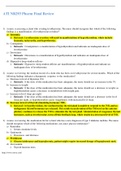Summary
Summary Biology B Edexcel: Topic 1 (A level)
- Module
- Topic 1
- Institution
- PEARSON (PEARSON)
I remember writing these notes in Y12, I know first hand the amount of time that has to be invested into this subject and how difficult it can be to identify the key information. These notes are time savers, giving you more time to practice questions and past papers. The notes used for all my A-lev...
[Show more]













